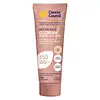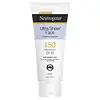Cancer Council Face Day Wear CC Cream Mineral Zinc Oxide SPF 50 Versus Neutrogena Ultra Sheer Face Lotion Sunscreen SPF 50
What's inside
What's inside
 Key Ingredients
Key Ingredients

 Benefits
Benefits

No benefits
 Concerns
Concerns

 Ingredients Side-by-side
Ingredients Side-by-side

Zinc Oxide 27%
Cosmetic ColorantAloe Barbadensis Leaf Juice
Skin ConditioningBenzyl Alcohol
PerfumingButyloctyl Salicylate
Skin ConditioningCaprylyl Glycol
EmollientCetyl Dimethicone
EmollientSilica
AbrasiveDimethicone
EmollientTocopheryl Acetate
AntioxidantGlyceryl Behenate
EmollientCI 77499
Cosmetic ColorantCI 77491
Cosmetic ColorantCI 77492
Cosmetic ColorantIsohexadecane
EmollientIsopropyl Palmitate
EmollientMagnesium Sulfate
Maltodextrin
AbsorbentPhenoxyethanol
PreservativePolyglyceryl-3 Diisostearate
EmulsifyingPolyhydroxystearic Acid
EmulsifyingWater
Skin ConditioningSorbic Acid
PreservativeStearic Acid
CleansingXanthan Gum
EmulsifyingZinc Oxide 27%, Aloe Barbadensis Leaf Juice, Benzyl Alcohol, Butyloctyl Salicylate, Caprylyl Glycol, Cetyl Dimethicone, Silica, Dimethicone, Tocopheryl Acetate, Glyceryl Behenate, CI 77499, CI 77491, CI 77492, Isohexadecane, Isopropyl Palmitate, Magnesium Sulfate, Maltodextrin, Phenoxyethanol, Polyglyceryl-3 Diisostearate, Polyhydroxystearic Acid, Water, Sorbic Acid, Stearic Acid, Xanthan Gum
Ingredients Explained
These ingredients are found in both products.
Ingredients higher up in an ingredient list are typically present in a larger amount.
Caprylyl Glycol is a humectant and emollient, meaning it attracts and preserves moisture.
It is a common ingredient in many products, especially those designed to hydrate skin. The primary benefits are retaining moisture, skin softening, and promoting a healthy skin barrier.
Though Caprylyl Glycol is an alcohol derived from fatty acids, it is not the kind that can dry out skin.
This ingredient is also used as a preservative to extend the life of products. It has slight antimicrobial properties.
Learn more about Caprylyl GlycolPhenoxyethanol is a preservative that has germicide, antimicrobial, and aromatic properties. Studies show that phenoxyethanol can prevent microbial growth. By itself, it has a scent that is similar to that of a rose.
It's often used in formulations along with Caprylyl Glycol to preserve the shelf life of products.